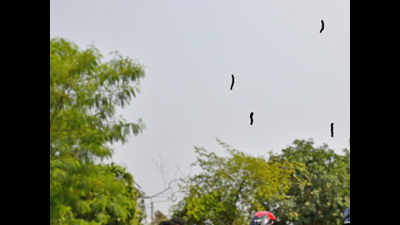- News
- City News
- mumbai News
- ‘Mumbai’s annual safe limits for PM2.5 not breached’
Trending
This story is from January 16, 2020
‘Mumbai’s annual safe limits for PM2.5 not breached’
For six months, from June 2019, that Central Pollution Control Board monitored air quality at 10 locations in the city, annual safe limits for the very dangerous, PM2.5 (particulate matter smaller than 2.5 microns) were not breached, but averages for PM10 (solid and liquid particles lesser than 10 microns) concentration was higher than safe limits at nine locations.

Mumbai's overall concentration was 96.16 µg/m3. (File photo)
MUMBAI: For six months, from June 2019, that Central Pollution Control Board monitored air quality at 10 locations in the city, annual safe limits for the very dangerous, PM2.5 (particulate matter smaller than 2.5 microns) were not breached, but averages for PM10 (solid and liquid particles lesser than 10 microns) concentration was higher than safe limits at nine locations.
City-based air quality research group UrbanSciences, which analysed CPCB data, said the average PM2.5 concentration at all locations was lower than the annual permissible limit of 40 µg/m3 (see box). The city’s overall PM2.5 concentration was 34.8 µg/m3 The highest average of 39.2 µg/m3 was found at Sion, followed by 38.04 µg/m3 at Kurla.
Track the pollution level in your city
On the other hand, PM10 concentration was higher than the permissible 60 µg/m3 at all locations, except Borivli. PM10 includes PM2.5. The city’s overall concentration was 96.16 µg/m3. The highest concentration was 112.46 µg/m3, recorded at Kurla.
Sutaria said the next step would be to scale monitoring networks using sensor-based monitors. “The city needs over 90 monitors. Permanent monitors are expensive but needed to know background levels. Low-cost sensor-based monitors could be considered to scale up the network,” he said.
City-based air quality research group UrbanSciences, which analysed CPCB data, said the average PM2.5 concentration at all locations was lower than the annual permissible limit of 40 µg/m3 (see box). The city’s overall PM2.5 concentration was 34.8 µg/m3 The highest average of 39.2 µg/m3 was found at Sion, followed by 38.04 µg/m3 at Kurla.
Track the pollution level in your city
On the other hand, PM10 concentration was higher than the permissible 60 µg/m3 at all locations, except Borivli. PM10 includes PM2.5. The city’s overall concentration was 96.16 µg/m3. The highest concentration was 112.46 µg/m3, recorded at Kurla.
While prolonged rain and a delayed winter could be a result of the lower PM2.5 concentration in the city’s air, UrbanSciences researchers said the data brings out only ambient pollution levels due to their locations. “For instance, the Powai monitor is placed inside IIT-B, a green space. Hence, the readings bring out the city’s background air quality levels when there is no man-made pollution, which is a good start. At some locations, monthly averages are as low as 15 µg/m3, which means unlike New Delhi, our city does not have poor air quality by itself. The city has a lot of emissions from very local sources,” said Ronak Sutaria, founder and director, UrbanSciences.
Sutaria said the next step would be to scale monitoring networks using sensor-based monitors. “The city needs over 90 monitors. Permanent monitors are expensive but needed to know background levels. Low-cost sensor-based monitors could be considered to scale up the network,” he said.
End of Article
FOLLOW US ON SOCIAL MEDIA










